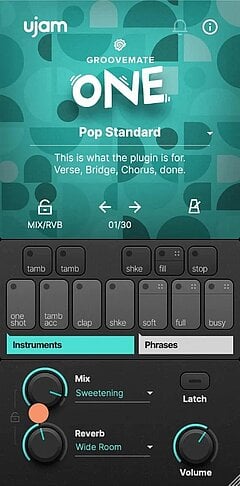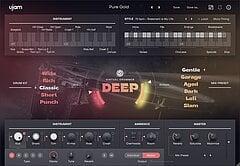How to Mix Percussion
Balance and punch up percussion instruments quickly for power, clarity and polish in any genre
JUNE 20TH, 2021
Getting the transients right
When someone describes a song as ‘punchy,’ they’re typically referring to how hard the percussion hits (and how fast the volume falls afterwards). Maintaining punch gets tougher as you add more instruments to the mix for a number of reasons, such as:
- Conflicting frequency ranges (i.e. lows, low-mids, etc.)
- Subtle timing differences staggering the hits ever so slightly
- Choosing instruments with less punch that ‘bloat’ the transients
Dealing with conflicting frequency ranges is dependent on a well-trained ear. Dip out the problem areas in the instruments that don’t need them — for example, if your shakers have a ton of bassiness, it was probably a mistake and you can simply high pass filter the instrument. Or since bongos are largely useful for that satisfying ‘smack,’ you can safely dip the low mids and focus the energy in the upper mids to help it cut through. While this varies from mix to mix, over time you’ll typically notice recurring trends. Take note of them and use them to make future mixes easier to finish!
Timing differences can be time-consuming to correct, but they’re easy to spot. Make sure your hits occur as close together as possible without sounding robotic and you typically can’t go wrong unless you specifically want the effect of a sloppier ensemble (which is surprisingly useful sometimes). Don’t quantize too heavily or your percussion will cease to sound natural — always leave some slack in the groove so it doesn’t sound forced. Watch the volume of each instrument as well: if a drum has weak transients, it may be perfect for a soft passage, but too loud during a strong one and it can weaken the whole groove.
The role of percussion in the mix
Percussion is one of the fastest ways to fill in dead space while adding to the movement of a song. For a list of some of the most common percussion instruments you’ll find, check out our article, The Ultimate Guide to Percussion — everything following in this article will make more sense!
Instruments like shakers, claps, snaps and plenty of others are quick to load up and implement — if you want to make this process even faster, give our Groovemate ONE a try. It’s more flexible than any traditional loop library yet provides percussion grooves you can instantly drop into any song. Out of the box, the samples are selected to stay out of the way of your core kick and snare beat, protecting your transients and building up the groove with little to no processing necessary!
Use this as your guiding beacon for every percussion-mixing decision: “Is this helping remove dead space in the mix and push the groove forward?” If not, don’t do it — it can be that simple. As you build up your production chops, you’ll find that your criteria evolve and expand. But whenever the mixing process drags on or you lose focus, return to this simple qualification statement to greatly simplify the mixing process.
Here are a few points to consider:
- Length of each hit’s ‘tail’ (the lingering portion of a percussion hit after the initial transient and the resonant ‘body’ sound)
- Sharpness and thickness of the transients
- Dynamic range, from too monotone and compressed to the volume becoming wildly out of control
- Reverb amount, from dry and raw to way too messy and washed up
- Strength of the fundamental pitch (if there is one), and whether it should be dialed up or notched out with EQ
This list could go on, but as long as you feel that each of the above five areas is solid, you’re on your way to a solid percussion mix! Most importantly, ensure the percussion doesn’t grow beyond the scope you want it to have. If it’s designed to be an accent, keep the volume relatively low. If it needs to drive the mix forward, don’t shy away from aggressive distortion and compression when that’s what it needs. Percussion’s role varies by genre too, so let’s look at how to approach some of the most common scenarios you may encounter as a music producer.
EDM vs. other genres
EDM requires a different approach to mixing than any other umbrella genre, because you’re going for a heavily processed feel. When adding percussion, you’re giving it an organic flavor to make things a bit more human — so you’ll want to strike a balance between a processed and natural feel.
You can compress percussion heavily in EDM, but you’ll need to pay attention to the releases — if they’re too long, the mix will rapidly become bloated. The tails should disappear quickly to make room. Tremolo and volume automation plugins can help a ton with this, such as LFO Tool and Tremolator; use a down ramp or downward sawtooth wave for drums, and a sinusoidal shape for softer percussion like shakers to accentuate their natural volume curves. If you dial in just the right amount, you can get away with adding a ton of percussion layers to thicken the sound without it ever becoming too much.
Also, be ruthless with EQing the low-mid and mid ranges — these are quickly muddied in EDM, and you can cut frequencies more aggressively without things becoming too thin. When applying the heavy compression associated with EDM, high frequencies can also build up, leading to a bandwidth-eating ‘hiss’; using a high shelf to slightly reduce the upper range will mitigate this and leave room for other instruments.
Lastly, when adding reverb, be subtle and don’t use the same reverb as other elements in your mix. Typically a low wet level, small room verb will do the trick — add just enough that you barely notice it while it’s in but everything sounds off as soon as you bypass it. EDM often uses some huge reverbs for pads and other chord instruments, but applying the same approach to percussion would rob the mix of the light pulse it provides.
Mixing drum fills
Depending on genre, drum fills are one of the most effective and fun ways to bridge the gap between sections! Dubstep, electro and other ‘high intensity’ electronic genres are a great candidate. Typically this means a lot of toms plus kick, snare, and cymbals; you can vary it up by choosing a ‘fill’ option with a single click in the Beatmaker of your choice, or load up an acoustic kit with one of UJAM’s Virtual Drummers for extra variety.
You’ll often want to approach drum fill mixes differently than the rest of the percussion throughout your track. They’re designed to ramp up intensity quickly into a drop or similar section, so don’t pull your punches here! Apply heavy compression with a short release, make them extra punchy, and even gate the drum tails if you choose. An alternative is using one of the volume automation plugins mentioned above — while this normally isn’t advisable with acoustic drums, all bets go out the window during drum fills. Do anything you can do to make them more powerful while staying consistent with the genre!
You can add as much as you want to the fills as long as things don’t get too messy. If you choose to add other percussion instruments like shakers, cajon, congas, etc., make sure to roll off the low frequencies with a high pass filter to remove anything that conflicts with the low toms and kick. Bass power is key! With fills, tend toward short hits with little sustain (i.e. not shakers or crash cymbals), at least until the beginning of the next section. This way, the next section will feel more expansive due to the added contrast. For more info on percussion grooves you adapt for your drum fills, check out our article, How to Add Percussion Grooves to Your Tracks to get some fresh ideas.
Wrapping up
Percussion has a wide range of uses, from filling in space to aiding the groove and even to adding a more natural feel to heavily processed tracks. Always know what purpose you want it to serve before anything else, because it will radically change the decisions you make (and the quality of the overall mix). Clarity is the first step to making everything else fall into place more easily.
Ultimately, the percussion mix should serve the overall mix of the song. If you hit an impasse where the needs of the percussion are at odds with the full mix, always prioritize the full mix — your audience will never listen to it in isolation, so make the song as a whole as accessible to your ideal listeners as possible. When the percussion acts in the best interest of the entire song, it’s in balance with everything else, neither too much nor too little. It takes time to get a natural feel for this, and the best way to do so is listen to songs analytically and mix as many tracks as you possibly can to gain more reference points. In time, you’ll become a master of all aspects of percussion production — take the time to really nail the art of mixing percussion, and your mixes will take on entirely new life!
About the Author
Harry Lodes is a copywriter, marketing consultant and content writer for audio and ecommerce brands. He lives in the Philadelphia area, releasing Eastern/Western hybrid EDM under the artist name KAIRI hearkening back to his roots in Berklee College of Music.
Stay up to date
Sign up and we’ll send you an e-mail with product news and helpful stuff every now and then. You may unsubscribe at any time.
Defy Limits
We develop software solutions that enable people to create, consume and interact with music.



